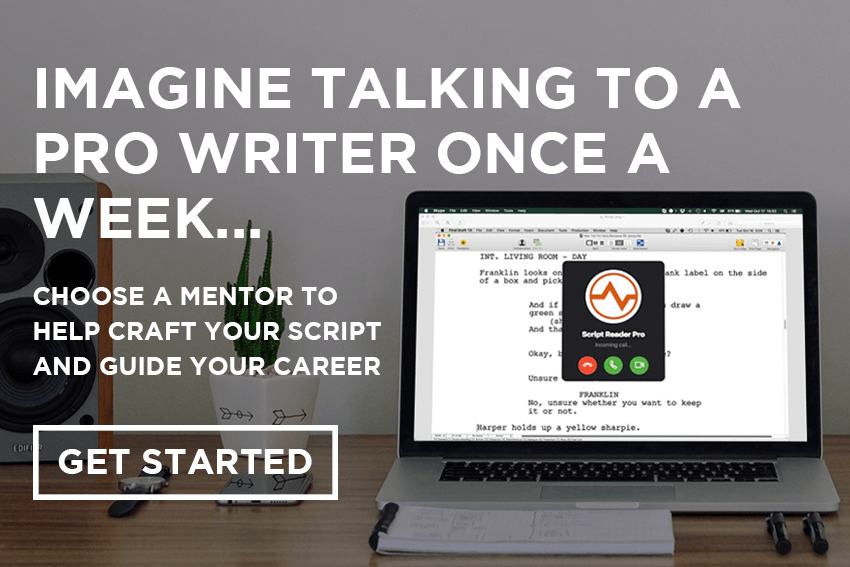
Are you obsessing over three-act structure? Here’s what you should do instead.
If there’s so much information out there on how to craft the perfect three-act structure, why is it so hard to put it into practice in your own script? Why is it so difficult to know how the hell to fill those 50-60 pages in Act Two?
With close to a million different theories on three-act structure out there, this confusion is easy to understand.
Should you structure your script using Christopher Vogler’s Hero’s Journey or John Truby’s 21 Steps? Or should you go for the Save the Cat Beat Sheet or maybe Syd Field’s classic three-act structure?
In today’s post, we’re going to show you why you should stop fretting over plot points, page numbers and all the different structure theories that are out there. And what to focus on instead.
We’re going to show you the pros and cons of three-act structure and the right way to approach it so it empowers your creativity rather than stifles it.
Here’s what’s coming up:
• What is three-act structure?
• Why three-act structure works
• The problem with this structure
• A better approach
• How to write a story by first forgetting three-act structure
• So, do you really need three-act structure or what?
So let’s dive on in.
First, just what is three-act structure?
As we’ve already mentioned, there are many different screenwriting structure theories out there. However, they all fall into and work in harmony with what’s known as “classic” or “traditional” three-act structure.
Here’s a quick breakdown of classic/traditional three-act structure in a movie screenplay:
A screenplay should be roughly 90-110 pages long.
A single page roughly equals one minute of screen time. So the sweet spot of a 110-page screenplay is about a one-hour-fifty-minute long movie.
Applying a three-act structure divides these pages/minutes up like so:
• Act One: First 25-30 pages/minutes
• Act Two: Second 50-60 pages/minutes
• Act Three: Third 25-30 pages/minutes
Or like this:
• Act One: Beginning/Set-Up
• Act Two: Middle/Confrontation
• Act Three: End/Resolution
Or, as the saying goes:
• Act One: Get your protagonist up a tree
• Act Two: Throw rocks at him or her
• Act Three: Get them down again
More detail on what classic three-act structure entails.
• Act one (the beginning) sets up the story world, the protagonist and antagonist and what’s at stake—the problem/crisis they have to resolve over the course of the story in direct opposition to one another.
• Act two (the middle) shows the protagonist and antagonist battling over this goal—what’s at stake in the story. Things get increasingly complicated for the protagonist as the antagonist reveals new obstacles and challenges them to ever greater degrees.
• Act three (the end) brings the story to a resolution when either the protagonist or the antagonist win the final battle, and what’s at stake has either been won or lost.
As the protagonist makes their way through the three-act structure paradigm, they’re hit by multiple crises that form major turning points in the story. For example, the Call to Action, Act One Turning Point, Midpoint and so on.

Why three-act structure works.
There’s a reason why this three-act structure paradigm has stood the test of time, all the way from Aristotle through to Frozen II…
Because it so effectively imitates real life and its recurring Rule of 3.
Think:
• Birth/Life/Death
• Sunrise/Day/Sunset
• The Son/the Father/the Holy Ghost
• Departure/Journey/Return
• Thesis/Antithesis/Synthesis
And so on…
Even on a day-to-day level nearly everything we do can be boiled down to a three-act structure paradigm.
Let’s say you get a call from the doctor asking you to come in for a scan because they noticed something unusual in your blood results.
• Act One might be thought of as the initial blood test and the doctor’s call asking you to come in for a scan (Set-Up).
• Act Two might be thought of the scan itself and any rising conflict and trauma that arises (Confrontation).
• Act Three might be the worry before you get the result which finally arrives letting you know you’re okay (Resolution).
In other words, a negative conflict arose with something that was at stake (You went up the tree). The conflict developed when you took an action (Rocks were thrown at you). And was resolved with a positive result (You came down from the tree).
Now that we’ve covered the basics of three-act structure and why it resonates with audiences, let’s take a look at some of its drawbacks.
The problem with three-act structure.
Three-act structure is a very useful tool when it comes to plotting a screenplay. As are the various structure theories that fit within it. Problems can arise, however, when too much emphasis is placed on them too soon in the development of a story.
In preparation for writing the first draft of a script, professional writers don’t usually sit down with a Save the Cat Beat Sheet and mull over what their “Bad Guys Close In” section will be between pages 55-75.
Aspiring writers, on the other hand, often do.
Some put three-act structure up on a pedestal as something at the forefront of their writing process and spend a great deal of time obsessing over its finer details, like “What event needs to happen on this page?” And… “How should this event happen?”
Here’s an excerpt from John Truby’s The Anatomy of Story in which he lays out the “Revelation 1 Sequence” in Alien:
• Revelation 1: The crew realizes that the Alien is using the air vents to move through the ship.
• Decision: They decide to flush the Alien toward the airlock and vent it into space.
• Changed Desire: Ripley and the others want to kill the Alien.
• Changed Motive: They must kill the Alien or die.
This is all perfectly true. But it also tends to make a writer impose structure on the story rather than let it emerge naturally.
If you try to work out your plot while stuck in the weeds of Revelations, Decisions, Changed Desires and so on, your mind is unlikely to be free enough to come up with a good story.
Overall, starting a script with three-act structure and these kinds of intricacies at the forefront of a writing process almost always comes at the detriment of character and story.
It usually leads to a script without much emotion or narrative sense, with events happening randomly, instead of organically because of a previous scene’s events.
Now, we’re not saying it’s impossible to write a great script with John Truby’s 21 Steps or the Save the Cat Beat Sheet at the forefront of your mind.
But if you really want to free your imagination to write the best story possible, then it’s a good idea to not start out in the weeds of three-act structure theory.
A better way to approach three-act structure.
First, step away from the books.
Remember: people don’t leave movie theaters thinking “Gee, I loved the way the Act One break happened slap bang on minute 25.”
Also, these three-act structure theories are the result of people analyzing a story that’s been written (probably) without those very same theories in mind.
In part two of this post we’re going to show you how all of these theories fit within three-act structure, but for now put them out of your mind.
Instead, focus on what’s most important: your characters and story.
How to write a story by first forgetting three-act structure.
The mistake many aspiring screenwriters make is trying to create structure before they write. In reality, structure occurs naturally when things happen to your characters and they make decisions and take actions as a result. Just like in real life.
As we’ve already discussed, the Rule of 3 is inherent to the human experience. And when applied to your script, this means the process of writing a story will naturally form a beginning, middle and end.
Rather than approaching story from the angle of index cards, “pinch points” and page numbers, focus on your characters’ goals and desires and the most interesting way you can show them.
Writing your story.
Getting started is actually really simple: Put all three-act structure theories out of your mind and write your story in prose form.
As you do so, it can be useful to ask yourself questions like:
• What’s the most natural and realistic thing this character would do next?
• If I were in this character’s shoes what would I do next?
• Is this scene a direct consequence of the previous scene?
• What’s the most interesting, surprising, exciting thing that could happen next?
• How can I make my protagonist really suffer?
• How can I make these scenes have the most possible impact on the audience?
• What would I be feeling if I was in a movie theater watching these scenes?
Keeping questions like these in mind as you write your story out in prose, is a great way of letting it come out of you naturally. As a result, your characters will start to behave more naturally and the story will feel more organic.
At this stage, it doesn’t matter if your turning points and act breaks aren’t “where they’re supposed to be.”
All that matters is that your story is compelling. You should be able to read aloud this prose version to someone and have them on the edge of their seat wondering how it all turns out.
If not, you’re still a long way from worrying about what page your midpoint lands on.
Focus on how your protagonist changes
The events your protagonist experiences and choices they make should profoundly change their humanity by the end of the story.
You’ve probably heard this be referred to as a “character arc” but, at this stage, it’s important not to associate the various points along their arc too rigidly within a three-act structure paradigm.
Simply focus on your protagonist’s journey by keeping at the front of your mind questions like:
• How do the events in my story force my protagonist to go from one state of mind to another?
• How do they make them go from taking one set of actions at the beginning to a completely different set of actions at the end?
• How do the scenes in my story logically lay out this evolution?
Think of all the highs and lows you can make us experience with your protagonist along the way toward their eventual triumph or failure.
Instead of focusing on plot points and page numbers, doing this should make your story naturally take on a beginning, middle and end—an Act One, Act Two and Act Three—that charts your protagonist’s change.
(Note: Of course, not all movies involve characters that significantly change, but the majority do. And, as an aspiring screenwriter, it’s well worth sticking to this paradigm. Unless you’re writing horror as traditionally the protagonist doesn’t really change much as the flaw is attributed to society rather than the individual hero.)
Conclusion.
In part two of this post, we’re going to break down several three-act structure theories as applied to the movie Up In the Air, showing how they are all saying roughly the same thing.
All of these theories—from the Blake Snyder Beat Sheet, to John Truby’s 21 Steps—can show you how you can tighten up an already existing great story to make it even better. Not how to write a great story from scratch.
No one can really do that as it comes from within your imagination. It comes from letting your imagination go and seeing where it takes you, instead of worrying about how it fits within three-act structure.
Remember to always start from the same place—character and story—and you’ll be fine.
###
How do you approach three-act structure? Do you forget about it when writing your first draft or is it something that you consciously think about from the very beginning? Let us know in the comments section below.
Enjoyed this post on three-act structure? Read more by following a link below…
Script Structure and Sequences: What They’re Not Telling You
Character Arc: The Secret Sauce to Demonstrating Your Hero’s Growth
How to Write a Screenplay: The Secret to Elevating It Above the Ordinary
[© Photo credits: Wikimedia Commons / Unsplash / Pixabay]

















I really love your tips, they are concise, and they have applicable suggestions. As a kid I must have consumed hundreds of films/TV shows, so that by the time I came accross Brad Snyder’s beat sheet and Joseph Campbell’s “The Hero’s Journey” models, they felt “intuitive”. I’ve found your tips on character profiles and “Save The Cat” books very helpful. Learn the “rules” ~so you know how to break them properly. Thank you! ✍️
Thanks a lot for this, Julian. We wish you all the best with your writing and here for you along the way!
Thank you for this article. I still want to know how should I break a 75 page script?
Act 1: 1-0 Pages
Act 2: 0-0 Pages
Act 3: 0-75 Pages
Hey Luner, 75 pages is kind of an odd length for a script – is yours a TV script or feature?
Good article and exactly what I’m going through now adapting a public domain novel. Structure was becoming my main problem and I realized how subjective beats like the catalyst or inciting incident can be. For instance, is it when the hero finds the map to the mine or when hhe finds the gold?
That’s great to hear – thanks for reaching out, Curtis 🙂
Save the Cat is very close to FORMULAIC writing. I agree with the STRUCTURE CONCEPT, but Writing a screenplay with the “CATALYST ” to fall exactly on page 12 is like “COOKIE CUTTER ” writing .
Your Thoughts. Glen
Spot on, Harry. If you hear anyone say a beat has to happen on an exact page number, they’re being too precise. I believe the Save the Cat page numbers are just guidelines, though.
I got down and just wrote my first draft and, as you say, let the imagination go! That was fun! The harder part is once you have your skeleton – then trying to put the correct parts of the meat on the bones! That’s been fun, too! But hard…
Yup, that’s the thing with this crazy thing called screenwriting. Enjoy the ride 🙂
Hey guys, is there an article like this for TV scripts? Thank you
This post on how to write a TV pilot has some info on structure.
This is a very fantastic article. I really enjoyed it and has educated me into details. Thank you ,i really appreciate that.
Thanks for the feedback, Eric!
And how can I reconcile these tips with the Script Hackr Course? After all, you divide the three acts into seven sequences, these sequences into three segments and among these three segments there are six major beats.
This post is showing you how to get to the heart of your story, and as we say in the course, sequences are best used after this stage to tighten everything up.
Where is Part Two? I could not find it through a search, and there wasn’t any link on the original to take me there. Thanks.
You must have been looking over my shoulder as I threw my pencil down and got torqued because I just couldn’t get the script going past the beats following the BS2 guides. Don’t get me wrong I completely devoured Blake Snyder’s educational book. It is a terrific educational document that I chose to buy as my first book purchase and self teaching of screenwriting. Let me stress here I LOVE THE CHALLENGE TO WRITE A SCRIPT!!!!
But, I really think he was trying to emphasize what you are saying here by telling me not to start writing just yet.
Back to your advice. The BS2 notwithstanding, I said, screw it, I am going to write it the way I want it. I outlined again in prose fashion and used a skeleton outline where I could lead out left or right horizontally from the main arc vertical and the prose idea fit right in. . ( I am doing an adaptation from a novel)
I tried to reason what was causing me this obstacle and, of course, it became too clear that I was trying to follow the script instructors map to close.
Now, my pencil is back in working order and I am out of the weeds of the BS2 but still use it’s guidance…albeit with much more broad mindedness. Regards to my fellow writers…Cherish the Holidays..
Thanks for the great comment, Lee. The Save the Cat stuff can be really helpful as you say, but usually more so when you use it as a reference point after writing your story, not before.
I’m adapting my book to a screenplay and was obsessing on limiting the number of pages per chapter. I have a much better idea of how to lay it out now.
Thanks,
Ken Lovan
Glad we could help. Thanks, Ken!
I’m adapting my book to a screenplay and was obsessing on limiting the number of pages per chapter. I have a much better idea of how to lay it out now.
Thanks,
Ken Lovan
Great, thanks for the comment, Ken 🙂
Fantastic piece! I definitely “obsess” over three act structure with my scripts way too much. Thank you!!
Glad it helped, Josh! Here’s to relaxing about three-act structure 🙂
Good article except a “Maguffin” is a red herring. It’s not properly described in your chart…
The chart is just a free image from the internet. We’re not saying this is how you should use three-act structure 🙂
“STRUCTURE OCCURS NATURALLY…” is a main TAKE OUT of this post and an effective antidote against the whole plot-point-page-number theory block. – a base of computer programs. (Moreover, Shakespeare himself had not even divided his plays into three acts. After his death, his editors introduced a five-part-division).
Yet, a three-act-structure is a useful guideline for me how to let the things happen. Further, I usually describe each and every scene on a card, as recommended by William Missouri Downs, Lew Hunter, Robin U. Russin and the others.
WITH MANY THANKS
Thanks, William! Our next post will be on how you can use these “competing” theories to help tighten up your free-flowing structure so stay tuned.
It’s good, but where is an example?
An example of?
I love any article that helps me relax about plot points hitting on certain pages. Excellent article.
Also is there any way in a future article you could address the different and best ways to show a time lapse in a story without always having to resort to cheesy montages? I’m writing script now that needs to show time changes and character growth (as in aging). I need advice on how to best and most creatively accomplish it. Thanks.
Thanks for the feedback, Glen. Yes, we plan on doing a whole article on montages. 🙂
My initial process of first getting the story premise down is kind of like a mix-master gone amok! I have to know who the characters are and what I think of them before I can decide if I have a worthwhile story. Perhaps I should note that there is often great disparity between what I think makes a good story and how Hollywood judges it.
Agreed – having a good sense of the characters you’re going to write about often comes first or very soon in many writers’ methods. Whatever works for you 🙂
Cool article, I agree that approach gives you more creative freedom. 😀
Thanks for the feedback!
Save the Cat is very close to FORMULAIC writing. I agree with the STRUCTURE CONCEPT, but Writing a screenplay with the “CATALYST ” to fall exactly on page 12 is like “COOKIE CUTTER ” writing .
Your Thoughts. Glen